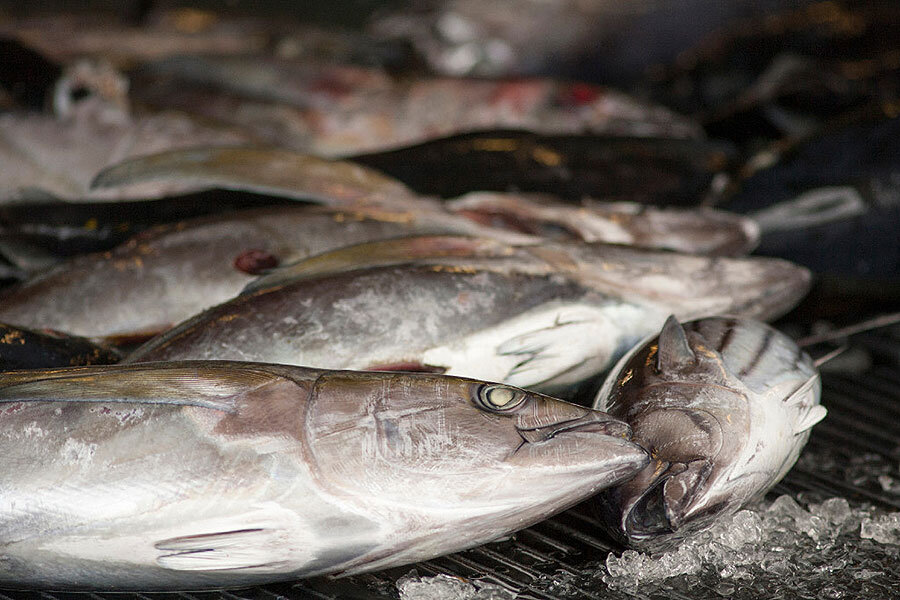Hawaii-based fishing relies on undocumented workers, report says
Loading...
Americans who reach for Hawaiian-caught seafood at the supermarket, thinking they're buying catch from American fisherman, might instead be buying fish caught by undocumented foreign workers – many of whom work under exploitative conditions because of legal loopholes, according to a new report from the Associated Press.
Hundreds of foreign workers form the majority of Hawaiian fishing labor, the AP found in a six-month investigation, and work for sometimes years at a time without work permits: rarely setting foot on American soil, living in often-squalid conditions, and paid below US minimum wage. These types of abuses are not unique in the fishing industry. Exploitation around the Pacific, including instances of labor trafficking, has gained attention in the past year, thanks in part to previous investigations by the Associated Press and The New York Times.
The most recent AP investigation of workers' conditions off the coasts of Hawaii found that some workers don't receive pay for months at a time, and often live in deplorable conditions. Some workers are forced to use buckets as toilets, while others face challenges getting medical attention for injuries.
"It's like, 'How is this even legal? How is this possible?' " said Forest O'Neill, who coordinates boat observers paid to monitor catch in Honolulu. "They are like floating prisons."
These fishermen catch about $110 million worth of seafood each year, but are paid as little as 70 cents per hour. Despite poor conditions and low pay, migrant workers from Southeast Asia and Pacific islands are willing to take jobs on the fishing vessels because although compensation is poor – frequently $350 to $600 per month – it is still a vast improvement on what they might earn at home.
Most do not have visas, and cannot set food on US soil without special permission: Technically, they're not working in the United States, making it difficult to apply labor laws. Many foreign fisherman work under a legal loophole permitting them to work without many standard protections. By law, three out of four fishermen on each commercial fishing boat must be American. However, the late Hawaiian senator Daniel Inouye and other lawmakers pushed for an exemption to the rule, hoping to protect the island state's stake in the fishing industry.
"It has the fig leaf of legality," Stephen Yale-Loehr, a law professor at Cornell University, told the AP. "This is inconsistent with the general notion in American values, if not law, that workers should be paid a fair wage and not be mistreated."
Last year, another Associated Press investigation revealed that modern day slavery situations in Southeast Asia, centered on a group of Burmese workers held on an island in Indonesia. The New York Times has also reported on abuses in the fishing industry, particularly in Thai fishing fleets. Fishermen and boys are often held in terrible conditions, physically punished for perceived wrongdoing, and, some workers say, sometimes even beheaded.
Fish caught by these fishermen can enter the supply chain of restaurants and grocery stores in the US. Although many major chains, including Wal-Mart, Costco, and Whole Foods say that they condemn these conditions, it is difficult to trace which fish have been caught by victims of labor trafficking or abusive conditions. Several of the US’s major fish suppliers and independent seafood distributors, such as Costco and Santa Monica Seafoods, say that they are investigating the treatment of the workers who supply their fish.
Still, the complex nature of the supply chain make it hard to crack down on the people behind the exploitation. Instead, some are reaching out directly to workers. Signs on Pier 17 in Honolulu tell fishermen in several languages who and where to call if they are victims of trafficking.
Technology can also help. In 2015, The Christian Science Monitor reported on the use of satellites to help monitor the oceans for evidence of maritime slavery, and trace where abusive employers' catch winds up on shore.
"There are six degrees of separation between the buyer on one end and the boat that's using slave labor on the other end," Georgetown University law professor Robert Stumberg told the Monitor at the time. "Anything that can help connect the dots is helpful."
"Even the US government is pushing for new technologies," the Monitor's Michael Holtz reported:
On Oct. 28, it launched a competition to find new high-tech solutions to labor trafficking in global supply chains in partnership with Humanity United, a Washington-based nonprofit organization. The grand-prize winner will be announced in April and awarded $250,000 to build a late-stage prototype of its design.
“There’s been a shift in the way that major corporations are thinking about what they need to do to tackle forced labor in their supply chains,” says Catherine Chen, director of investments for Humanity United. “There’s a really unique opportunity here.”
This report includes material from the Associated Press.








